Post by ChrisB on Feb 19, 2019 21:36:06 GMT
A History of Mark Levinson Audio Systems
by Chris Bennett and Barry D. Hunt
(Note: This article is restricted to predominantly cover the years that Mr Mark Levinson was involved with the company. It is a slightly refreshed version of the one that Barry and I wrote several years ago, but was never made publicly available.)
Mark Levinson, or to give it its full name of Mark Levinson Audio Systems was founded by Mark Levinson in Woodbridge, Connecticut in 1972 [1]. As the YouTube clip cited below shows, Levinson started out as a keen jazz player – he plays double bass, trumpet, flugelhorn, and sarod (a North Indian stringed instrument). Before the age of 20 he was sitting in playing double bass and trumpet, with the likes of John Coltrane, Sonny Rollins, Sonny Stitt, Johnny Griffin, Chick Corea and Keith Jarrett. He played in the band of Paul Bley from 1966 to 1971 and at the age of 22 he designed the mixing board that was used at the Woodstock Music Festival. He was also interested in Indian music and planned to go to India to study. En route he stopped off in Switzerland and visited the Stellavox Company, presumably to purchase one of their portable tape recorders. Whilst there, he was so impressed by the build quality and the care with which Stellavox recorders are designed and made, that he had a change of direction and decided to return home to start designing and supplying high quality audio components in the USA, inspired by the work of the Swiss company [2].
The LNP-2 Professional Preamplifier

LNP-2 preamplifier
The first product produced by Levinson was the LNP-2 preamplifier. This was a preamplifier intended for the professional user and sported a comprehensive range of features that was almost unique for the time:
• Provision of both balanced and unbalanced inputs and output. XLR connectors provided the balanced connections. The unbalanced connections eschewed the common RCA ‘phono’ connectors of the day and replaced them with gold plated CAMAC connectors, unique to Levinson designs.
• Precision input and output level potentiometers.
• Phase inversion switching.
• Comprehensive tone controls that could, if wished, be switched out of the circuit.
• Level meters whose ballistics could be switched between mean and peak level, and had a sufficiently fast rise time that they could respond to the first quarter cycle of a 20KHz sine wave.
• Circuit divided into modular units, which plugged into a ‘motherboard’.
• 140dB dynamic range.
• 110dB channel separation up to 20 kHz.
• Channel-to-channel tracking within 0.1dB.
• Use of Teflon insulated wire and screened cable.
These preamplifiers were extremely well made, the care extending to the front and rear panel legends that were engraved and white filled, rather than using lettering that was screen-printed and could wear off with use. Surprisingly, despite the extremely high price for the time of $1,750 thousands of these units were sold, mostly to the professional market.
The JC-1 Moving Coil Head Amp
Levinson’s first foray into the domestic audio market came about in 1972 with the moving coil booster amplifier, the JC-1. The initials refer to the designer John Curl, who's first job as an audio engineer was working on design of tape recorders at Ampex. Later, he had successfully designed amplifiers for the American group ‘The Grateful Dead’. Two versions were made: a battery powered version, the JC-1DC and a mains powered version, the JC-1AC.
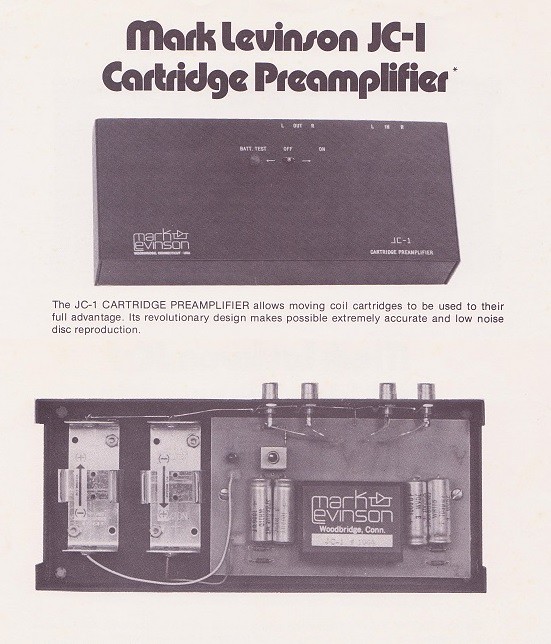
The JC-1 head amp
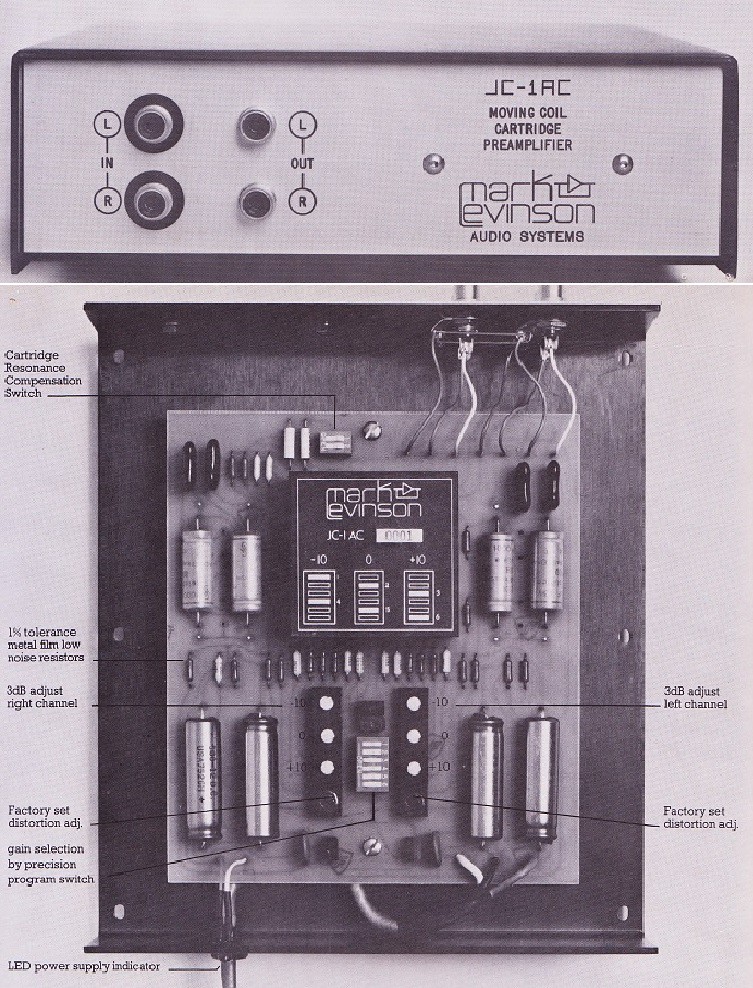
JC-1AC head amp
To appeal to the domestic user, the input and output connections used RCA phono connectors. This was the only concession to the domestic market, the build quality was the same as that of the LNP-1, with engraved and filled lettering. Trial samples were favourably received by notable audio dealers, and based on their endorsements Mark Levinson quickly established itself as a top quality marque. This was despite the high selling price; even today used samples of the JC-1 fetch four-figure sums.
The JC-2 Preamplifier
Following the success of the JC-1, the next design aimed at the domestic market was the JC-2 preamplifier. Introduced in 1974 it remained in production until 1977.
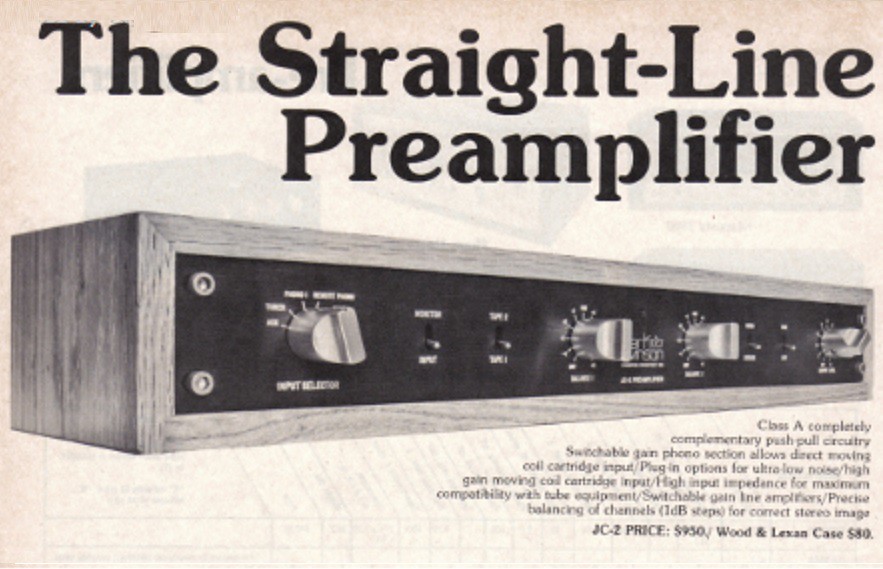
The JC-2 preamplifier

Interior of the JC-2 showing modular construction
Employing simple circuitry this John Curl design was a scaled down version of the LNP-2 dispensing with the facilities that would not be required by domestic users but retaining the high build quality. Surprisingly for an item intended for domestic use, it was designed for 19” rack fitting, although a wooden sleeve or case was made available. It received very favourable reviews at the time, despite the high price. Again for the domestic market RCA connectors were employed as in the JC-1, though later versions of the JC-2 came equipped with CAMAC connectors.
The ML-1 Preamplifier
Introduced in 1977 this is the first design to be given the new ‘ML-‘ designation. The ML-1 is virtually identical to its predecessor the JC-2. John Curl parted company from Levinson, going on to work with Harmon-Kardon, Gale, SOTA, Saul Marantz (in The Lineage Group) and Parasound where his basic design for the JC-2 continued in the Halo JC-2 preamp, also producing his own Vendetta Research phono amplifiers.
Mark Levinson redesigned the external power supply and renamed the preamplifier the ML-1. It was the first domestic design to use CAMAC connectors as standard, a practice that would continue to be used on all Mark Levinson equipment up to 1995. The front panel, controls and facilities are the same as that of the JC-2. Custom plug in modules were available, allowing a variety of pick up cartridges to be accommodated as outlined below:
A3 phono module: 50k/100K input impedance and 30dB/40dB gain.
A4E phono module: 820/50K input impedance and 44dB/38dB gain.
A5 phono module: 50K input impedance, gain 30dB, saturation level 200mV
or 100K input impedance, 40 dB gain, saturation at 90mV.
D5 moving coil phono module: with 54 or 60db gain.
D6 moving coil phono module: gain 60 or 66dB.
Production discontinued in 1980.
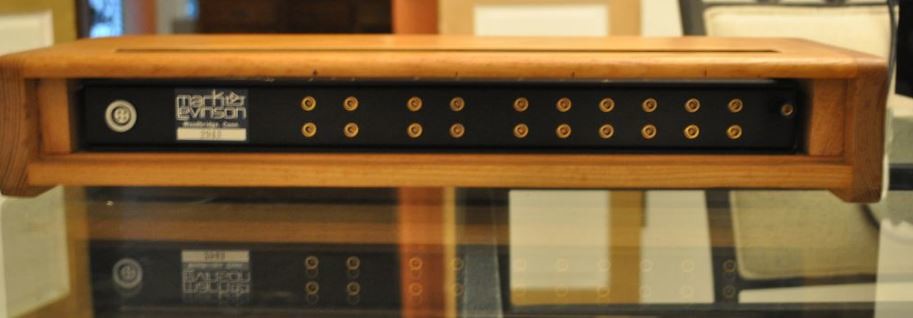
Rear view of the ML-1 showing the CAMAC connectors.
The ML-2 Power Amplifier
This power amplifier is the last design for Levinson that John Curl made. The prototype (pre-production) John Curl design was called the JC-3.
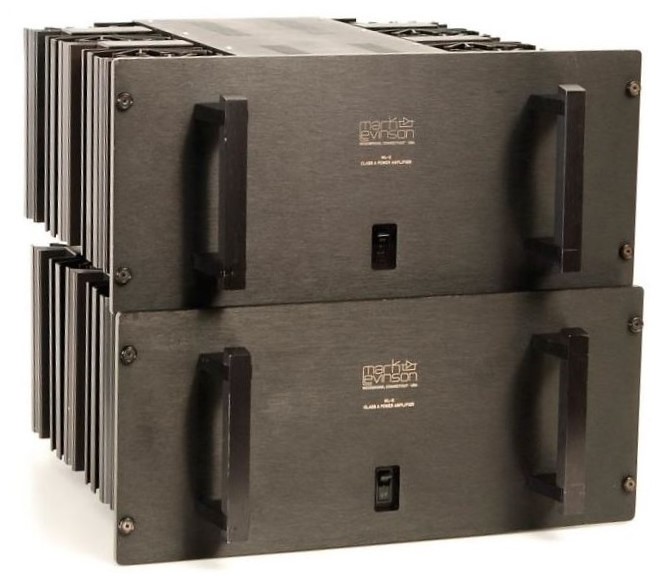
The ML-2 was based on the JC-3, and was completed by Levinson’s chief engineer, Tom Colangelo. The design went into production in 1977.
MLAS recognised that there was more to sound quality than measured figures and only supplied specifications that related directly to the operation of the amplifier. A 25-watt single channel (monoblock) amplifier operating in class A, the ML-2 would develop 50 watts into 4Ω and 100 watts into 2Ω. The ML-2 used a high quiescent current, causing it to dissipate some 400 watts whilst idling and consequently ran very hot. Because of the high running temperatures there were reliability problems. Production stopped in 1986.
The ML-2 was able to source a current of 8A into 10Ω, owing to the fully regulated power supply possessing a claimed equivalent of 1Farad of smoothing/storage capacitance. It had both normal and inverting inputs and was bridgeable to give four times the rated output power. There was also an option for the ML-2 to be fitted with XLR connectors for balanced inputs.
It was designed to partner the ML-1 preamplifier. Again the ML-2 was favourably received and is considered by many to be an excellent amplifier with which to drive the Quad (57) electrostatic speakers. Despite the seemingly low 25W into 8 ohm output power, the ability to double this progressively as impedance was halved, coupled with high current delivery made the ML-2 the favoured amplifier to drive the original full range Apogee loudspeakers with their 0.3 Ohm load.
The LNC-2 Electronic Crossover
Designed to be part of a three way active speaker system: the Levinson HQD system, this electronic crossover was based on an earlier LNC-1 design (itself based on proprietary Burwen modules). The LNC-2 was a single channel 2-way active crossover. The crossover frequencies were chosen by the customer, these rolling off at 18dB/octave. Optional modules rolling off at 6dB/octave were available (designated OCS modules). Changing the crossover frequency was achieved by changing modules.

LNC-2 Electronic Crossover
The LNC-2 featured 10 turn precision potentiometers allowing the respective output levels to be set to a resolution of 0.1dB. For those systems that use a common (single) bass unit, a ‘mono’ switch inside the unit could be set to route the low frequencies to a common output.
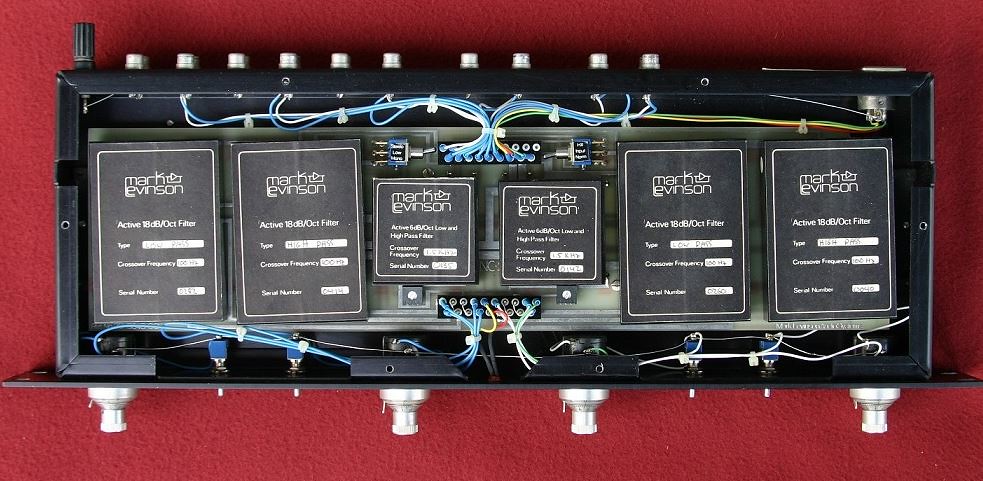
Interior view of the LNC-2, showing the crossover modules
Two LNC-2s could be configured for three-way systems. For three-way active systems, an LNC-2 would be used in each channel set to mono mode. In this case each LNC-2 would have one low pass and one high pass filter for each of the two crossover frequencies.
The design went into production in 1976 and continued to 1993.
The development of the ML-1, ML-2 and LNC-2 were necessary steps to be made, leading up to the creation of the Mark Levinson HQD reproduction system.
The Mark Levinson HQD System
This is Levinson’s tri-amped active replay system and can be regarded as a tour de force, each of the two channels comprising a woofer using a 24” Hartley drive unit fitted in a large (24 cubic foot) enclosure, a pair of stacked Quad electrostatic speakers for the mid range and between the two Quad speakers a Decca (Kelly) ribbon tweeter for the treble, the latter modified by having the horn removed. Each speaker was driven by a separate ML-2 amplifier fed by a LNC-2, this in turn being fed by an ML-1 preamp.
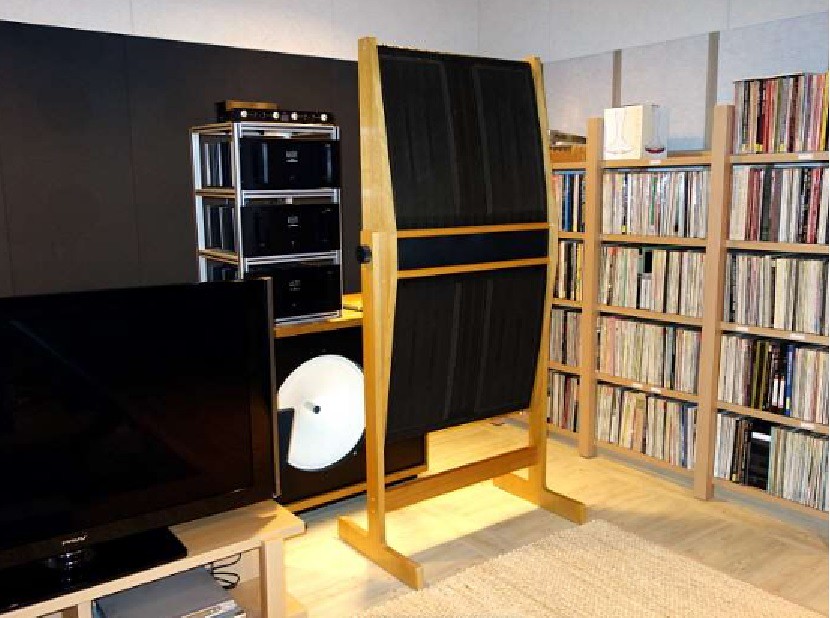
Thus the system consisted of:
• 1 ML-1 preamplifier
• 2 LNC-2 electronic crossover units and their PLS-151 power supplies
• 6 ML-2 power amplifiers
• 2 Hartley woofer units fitted into (4’ x 3’ x 2’) enclosures
• 4 Quad speakers
• 2 modified Decca ribbon speakers
For the HQD system the LNC-2 had the crossover frequencies set at 100Hz (bass/mid) and 7KHz (mid/treble).
To complement the HQD system, Levinson introduced a range of interconnects and speaker cable. For the low level interconnects Levinson offered a pure silver coaxial cable having a PTFE dielectric insulation and dimensions similar to that of RG58. It came terminated in Fischer CAMAC plugs. Two types of speaker cable were offered: one, designated HF10C, consisting of 2500 strands of 0.07m dia. copper wire (total cross section: 10 square mm); the second, designated HF2.5, a smaller cable consisting of 600 strands of 0.07mm dia. copper wire (total cross section: 2.5 square mm). Both speaker cables were of 'figure of eight' or 'dumb-bell' geometry with a 6mm wide strip separating the conductors. In conjunction with the Swiss company Fischer, a speaker connector was developed. This was made available July 1979 and appears in the Fischer catalogue as item 107 A001.
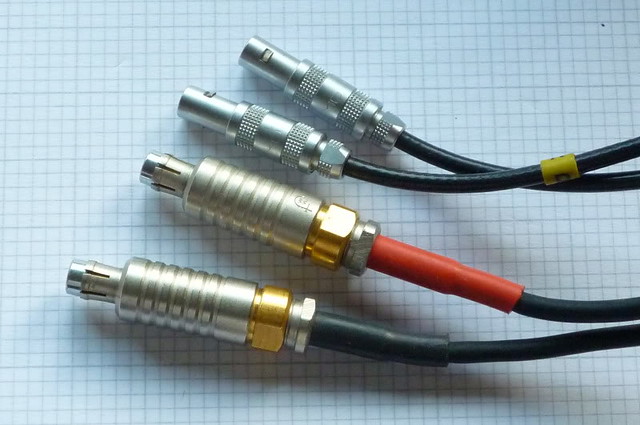
Interconnects terminated with Fischer Camac connectors - top pair from Lemo, lower pair from Fischer. (Photo: Barry D. Hunt)
It is not known how many HQD systems were sold, since owing to the very high total cost, few could afford to buy it.
The ML-3 Power Amplifier
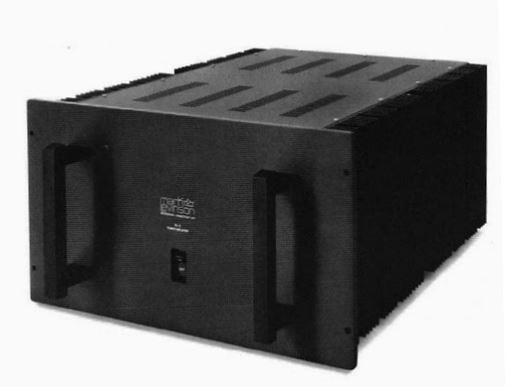
This was a 200-watt per channel dual monophonic amplifier using separate power supplies and mains transformers. Introduced in 1979 it continued in production until 1987. Designed by Tom Colangelo it received reasonable reviews, though the sound quality was thought by some to be not up to the high standard of the ML-2.
The ML-3 had the following specification:
• 200W/ch into 8Ω, 400W/ch into 4Ω, 800W/ch into 2Ω.
• Max output: 45 Volts at 30 Amps (1.35kVA).
• Two 1.2 kVA torodial transformers, 4 x 36,000μF capacitors and 40 output devices (20 per channel).
• Range: 20 Hz - 20 kHz with less than 0.2% THD.
• Adjustable Output Damping Toggle Switches (one per channel)(in later models only).
Maximum power consumption occurred into 2Ω loads, with both channels driven to just below clipping: 2.5kW. Quiescent power consumption was 180W.
The ML-5 Master Recorder
Based on a Studer A80 RC transport with two track heads for 2” wide tape, the ML-5 was developed by Levinson to allow him to make a small range of high quality recordings, the Mark Levinson Acoustic Recording Series (MLAS). The Studer electronics were replaced by those developed for the ML-1 preamplifier. Purchasers of the tape decks were also offered direct tape copies of the master tapes of the high quality recordings that were released on vinyl (see Mark Levinson Acoustic recording Series below). Levinson recommended the use of Bruel & Kjaer 4133 microphones and produced the ML-8 microphone preamplifier. It was also recommended that a pair of ML-2 amplifiers were ideal for driving cutter heads. Production ran from 1981 to 1986.
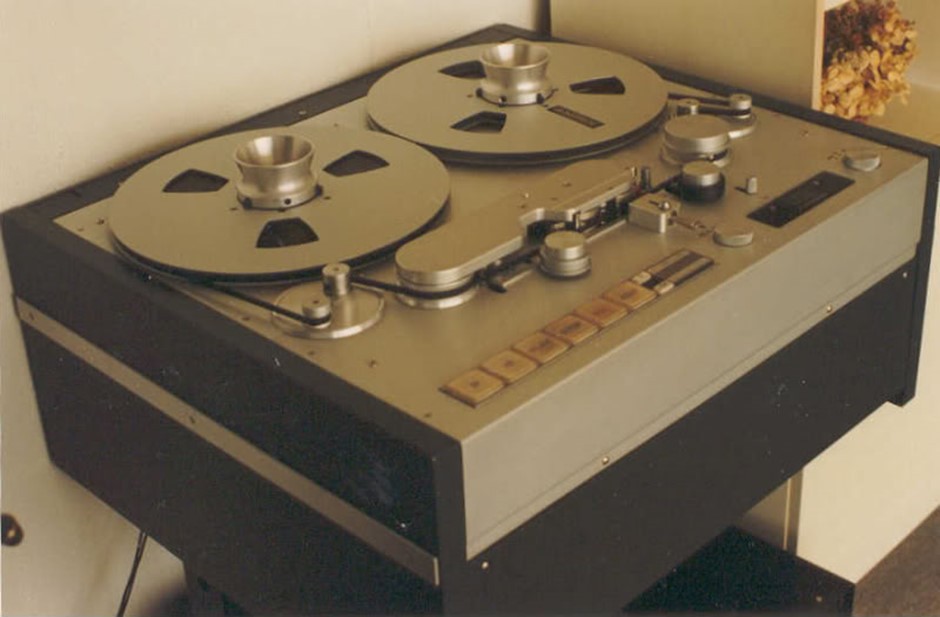
Other Pre and Power Amplifiers
Other components were later developed: the ML-6 (1979 - 1980), a twin mono preamp where the channel separation extended to having each channel in a separate case with its own volume control, one phono and one line input and no other functions. There were three versions: the L2, L3 and L3A, depending on the input cards fitted – each option giving a different level of gain. The phono input could be substituted with a second line level input. Line level gain was selectable via pcb mounted switches offering 10, 20 or 26 dB. Power for each channel came from separate PLS-154 power supply units. Two upgrades followed, the ML-6A (1981 - 1985) and ML-6B (1985 - 1989); some of these units came from Woodbridge assembled by Mark Levinson. The ML-7 (1980 - 1985) was another preamp, a more flexible (more line level inputs, two tape loops with monitoring & two phono stage inputs, replaceable with one or two line stages) and domestically acceptable alternative to the ML-6, returning to the use of a single case, the design itself being upgraded as the ML-7A (1985 - 1989). As for the ML-6, power was derived from the PLS-154
The ML-9 (1984 - 1988) was a 100W/channel stereo power amplifier intended to be partnered with the ML-7 or ML-10 preamp. The ML-9 was marketed as a half sized ML-3, but in truth there was a different power supply arrangement.
A new preamplifier the ML-10 (1981 - 1984) and its subsequent upgrade the ML-10A (1984 - 1988), were the first to have onboard power supplies and had inputs for one phono, two line and one tape loop.

ML-10A preamplifier (Photo: Barry Hunt)
The 50W/channel ML-11 (1982 - 1989) power amplifier was designed to be paired with the ML-12 preamplifier (1984-1984)' later upgraded to the ML-12A (1984 - 1988). The pre drew its power from the power amplifier or from the separate PLS-154 power supply unit and provided one phono, one line and one tape input with monitoring. The power amp was designed to be bridgeable by the user in order to produce 140 watts into 8 ohms. As with all Levinson power amps, the ML-11 doubled its rated power output into each subsequent halving of impedance.
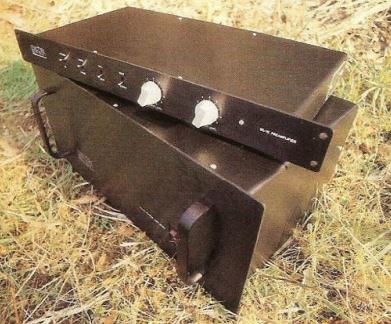
ML11 Power and ML12 Preamplifier
The MLC-1 Moving Coil Cartridge
Nakamichi designed this moving coil cartridge to Levinson’s specification. The cartridge is thought to have been made for Nakamichi by Myabi; the designer was Haruo Takeda. Only about 100 units were made. No specification was issued, the following information is provided by users: cartridge weight 11g, tracks at 3g and has a coil resistance of 3Ω.[3] It was fitted with a PA Ogura line-contact stylus, having dimensions 8um x 140um.
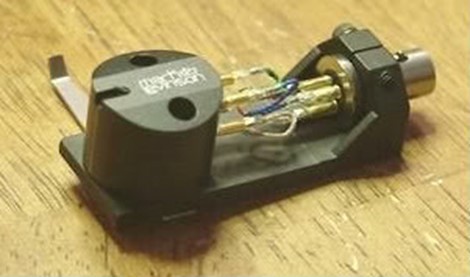
Mark Levinson Acoustic Recording Series (MLAS)
A short series of high quality recordings were made by Levinson using the Levinson modified Studer tape recorder, the ML-5. The titles released were as follows:
MAL 1 ‘Volume I, The Six Schubler Chorales’, J. S. Bach (1976)
MAL 2 ‘Volume II, Valse Nobles et Sentimentals, Hadyn Sonata no, 49 Eb major’, Lois Shapiro (piano) (1976)
MAL 3 'Bill Elgart - A Life (Percussion Suite)' Jazz drum kit & percussion, Tracks: Birth, Sleep, Sense, Feeling, Thinking, Social, Ideological, Nirvana, Old Age, and Death.
MAL 4/1 ‘Volume IV, Sonatina (A. Homzy), Concerto (Vivaldi – Bach, arr. Baldwin), Amor Vittorioso (G. Gaslotde), Brittanica for Bass (arr. Baldwin), Mirabile Mysterium (J. Handl), Ricercar Brevis (J. P. Sweelink)’ (1976)
MAL 4/2 ‘Volume IV, Four Madrigals (P. Hindemith), Trios Chansons (C. Debussy), Four Songs (C. Ives, arr. Singleton), Magical Mystery Tour, Penny Lane, Ob-Bla-Di Ob-La-Da (The Beatles, arr. Baldwin)'
MAL 5 'J.S. Bach - The Art of the Fugue': 4 lp (45rpm)
MAL 6 ‘Elliot Fisk Plays Scarlatti and Bach’
MAL 7 ‘Jazz at the Long Wharf’ (45rpm)
These recordings are now out of print and owing to their scarcity fetch high prices on the second-hand market.
Equipment Price List
To give an idea of the high cost of Mark Levinson items, the following are 1981 prices quoted by Harman (Audio) UK Ltd., the UK distributor for Levinson.
Preamplifiers:
LNP-2 £4000
ML-6 (L2 module) £4500 a pair
ML-6 (L3 or L3A ) £4900 a pair
ML-7 (L2 module) £3400
ML-7 (L3 or L3A ) £3900
ML-10 £2200
L2 phono modules £725 a pair
L3 or L3A modules £1175 pair
Power Amplifiers:
ML-2 £5200 a pair
ML-3 £4400
ML-9 £2000
Other Items:
HF10c speaker cable £12 /metre
Silver coaxial cable £37 /metre
A Mark Levinson customer price list of January 1980 gives the following prices (quoted in Stirling using the conversion rate at the time of £1 = $1.86):
LNP-2 £2487
LNC-2 £1344
JC-1S £97
ML-1 (fitted with A3 or A3E cards) £1202
ML-1 (fitted with D5 or D6 cards. ) £1290
A3, A4E, D5 or D6 cards £50
MLC-1 Moving coil cartridge £328
ML-5 Master recorder £13,286
LNP-2 Recording system:
Bruel & Kjaer 4133/2196 microphones £505 each
ML-8 microphone amplifiers £457 each
B&K option installed in LNP-2 £161
Hartley 24" woofer £172 each
Modified Decca ribbon tweeter £320 /pair
HQD stands (each including a pair of Quad 57 ELS) £1200.
However it is more realistic to take the price in dollars as the retail price in the UK, to allow for import duty and distributor's costs.
From these figures, the cost of a complete HQD system (including a full set of Levinson interconects) would be around £36,000. Translated to today's prices (2019) this figure becomes £150,388.17 (Conversion: UK Govt. Office of National Statistics Composite Price Index).
In the 1980’s the Mark Levinson company was bought out by Madrigal, one of Levinson’s biggest dealers. Since then Madrigal continued to develop items under the Mark Levinson name, with a change of designation from ‘ML-‘ to ‘No.’. The most notable of their products was the No.20 power amplifier and the No.26 and No.28 preamplifiers as well as introducing digital source equipment. Over the period 2000 to 2002, the Harman International Group bought out Madrigal and with it the Levinson name.

No.28 preamplifier (Photo: Barry Hunt)

No.26 preamplifier (Photo: Barry Hunt)
Levinson himself went on to found Cello, retaining Tom Colangelo as chief engineer and continued the mainframe and plug-in module approach to preamplifier configuration. Cello's landmark products were the Audio Suite preamplifier and the Audio Palette equaliser. The Palette was an extremely sophisticated product assembled from over 6000 individual components. There were nine hand-built attenuators built around 59-position switches. The controls were hand-machined and the front panels were hand-engraved; cabling was Teflon-jacketed silver and connections were made via the now-trusty Camacs. The result was < 0.1dB channel tracking and a > 110dB dynamic range. The Palette cost $7.5K in 1984 when it was introduced, a price which rose to $25K by the end of its 2005-year production. It sold well to recording companies and the manufacturers of audio equipment.
In 1998 Levinson went on to found Red Rose Music, introducing a range of badge engineered Chinese built components, notably valve power amplifiers and ribbon speakers, the latter designed by the Swedish designer Bo Bengtsson.
In 2007, Levinson moved to Switzerland and started the Daniel Hertz company to produce a range of loudspeakers, amplifiers and music software. The loudspeaker cabinets were constructed by the Petrov Piano Company.
Tom Colangelo founded Viola Laboratories and died in a car accident in 2007.
Other Sources and Acknowledgements
[1]
Wikipedia quotes this date, yet company literature for the ML-2 amplifier quotes 1971.
[2]
[3]
This data differs slightly from that given on the 'vinyl engine cartridge database':
www.vinylengine.com/cartridge_database.php
A wealth of information on early Mark Levinson designs can be found at:
marklev.com/
This site has links to others showing promotional literature, reviews, schematics and user manuals for many Mark Levinson products. Unless otherwise stated all the photographs here (used for illustrative purposes only) have been obtained from this site.
Yahoo Mark Levinson Group – focuses on older ML equipment.
groups.yahoo.com/group/marklev
Stereophile Review of Mark Levinson ML-7A preamplifier
By J. Gordon Holt, August, 1986
www.stereophile.com/solidpreamps/mark_levinson_ml-7a_preamplifier/index.html









